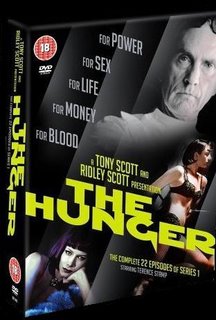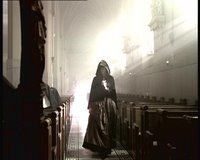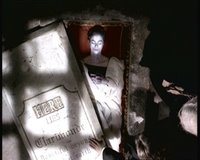 The Hunger was a supernatural TV series of short films produced by Tony and Ridley Scott. Despite the involvement of Tony Scott and the name of the series this was not related to the 1983 movie, though the series DVD insert claims it was inspired by said film. The subject matter of the episodes changed but what remained constant was an obligatory sex scene, some naked flesh and (often) flashes of lingerie. Season 1 was introduced, episode by episode, by Terence Stamp. The series itself is very good generally; however the quality can vary, from the pure horror (good) through to something like the Red Shoe Diaries with a murder/supernatural twist (poor).
The Hunger was a supernatural TV series of short films produced by Tony and Ridley Scott. Despite the involvement of Tony Scott and the name of the series this was not related to the 1983 movie, though the series DVD insert claims it was inspired by said film. The subject matter of the episodes changed but what remained constant was an obligatory sex scene, some naked flesh and (often) flashes of lingerie. Season 1 was introduced, episode by episode, by Terence Stamp. The series itself is very good generally; however the quality can vary, from the pure horror (good) through to something like the Red Shoe Diaries with a murder/supernatural twist (poor).
Though it is not credited as such, Clarimonde was based upon the story by Theophile Gautier called “La Morte Amoureuse.” This is described, by Leonard R N Ashley, in “The Complete Book of Vampires” as a story “which deserves to be better known. It is the story of Clarimonde, who seduces and has an affair with a priest, but the priest’s superiors discover this and also the fact that Clarimonde is a vampire.”
The episode follows very closely the story, though it misses one distinct element within its representation.  It begins with the novice Romauld (David La Haye) at his ordination. A woman (Audrey Benoit) enters the church. When he is asked whether he will dedicate himself as a priest he says no and then quickly changes his mind and says yes. The woman looks bitterly disappointed.
It begins with the novice Romauld (David La Haye) at his ordination. A woman (Audrey Benoit) enters the church. When he is asked whether he will dedicate himself as a priest he says no and then quickly changes his mind and says yes. The woman looks bitterly disappointed.
Romauld is taken to his new parish, an isolated church amongst the snowy wastes; on route he seems to see the woman. He discovers that the previous priest was unable to handle the isolation and hanged himself.
One night a man comes, waking Romauld as his mistress, Clarimonde, is dying. Arriving at the mistress’ home she is dead, her face covered with a sheet. He removes the cover and it is the woman. He kisses her lips and she awakens but when she tries to kiss him properly he pulls away. Waking in his own bed he is  unsure as to whether it truly happened or of it were a dream.
unsure as to whether it truly happened or of it were a dream.
When he is sleeping again she comes to him and they become lovers. He tells her that he loves her, more than he loves God. The nightly visitations continue and he is unaware as to whether she is a dream phantom or not. As he muses, he wonders whether he is a priest who dreams of her or her lover who dreams he is a priest. The next time he is with her, Clarimonde tells him that the following night her carriage will take them away.
Fearful he begs God to help him stay awake. His superior comes in and drags him to a crypt. He tells him that the woman he loves is a succubus, a witch who has chosen him to bring her to life as she needs the love of a man devoted to God.  His superior opens a tomb and Clarimonde is there, perfectly preserved. At his superior’s urging he renounces her and she turns to ice. The film really concentrates on faith, do we place faith in the physical or the divine and are we actually aware if what we place our faith in is real. Thus the renouncement destroys Clarimonde in this, whereas in the original story she is destroyed with holy water. This theme of faith is underlined in the epilogue, forty years later, when a new priest comes to replace the (now) old Romauld. Romauld asks him why he would choose such a desolate parish and the younger man reveals he wants to test his faith. Romauld looks towards the crypt and admits that it is a good place to do that.
His superior opens a tomb and Clarimonde is there, perfectly preserved. At his superior’s urging he renounces her and she turns to ice. The film really concentrates on faith, do we place faith in the physical or the divine and are we actually aware if what we place our faith in is real. Thus the renouncement destroys Clarimonde in this, whereas in the original story she is destroyed with holy water. This theme of faith is underlined in the epilogue, forty years later, when a new priest comes to replace the (now) old Romauld. Romauld asks him why he would choose such a desolate parish and the younger man reveals he wants to test his faith. Romauld looks towards the crypt and admits that it is a good place to do that.
On the surface there is very little vampiric about this, which amounts to the missing elements I mentioned at the head of this piece, Clarimonde’s visitations are distinctly succubi in nature and she is also accused of being a witch, whereas in the original story there is a definitive accusation of vampirism and the consuming of blood, albeit in small quantity as this evocative quote illustrates:
“In the act of cutting some fruit I accidentally inflicted rather a deep gash on my finger. The blood immediately gushed forth in a little purple jet, and a few drops spurted upon Clarimonde. Her eyes flashed, her face suddenly assumed an expression of savage and ferocious joy such as I had never before observed in her. She leaped out of her bed with animal agility—the agility, as it were, of an ape or a cat—and sprang upon my wound, which she commenced to suck with an air of unutterable pleasure. She swallowed the blood in little mouthfuls, slowly and carefully, like a connoisseur tasting a wine from Xeres or Syracuse. Gradually her eyelids half closed, and the pupils of her green eyes became oblong instead of round. From time to time she paused in order to kiss my hand, then she would recommence to press her lips to the lips of the wound in order to coax forth a few more ruddy drops. When she found that the blood would no longer come, she arose with eyes liquid and brilliant, rosier than a May dawn; her face full and fresh, her hand warm and moist—in fine, more beautiful than ever, and in the most perfect health.”
La Morte Amoureuse, Theophile Gautier 1836Despite the fact that this is based on an early, often overlooked, vampire story, I am going to have to say not vamp, but recommend this episode to any student of the genre as a good representation in essence. After all the story (as I indicated) was not credited as the source of the episode and yet I recognised the story immediately. Anyone wishing to read the original can find it here.
The imdb page is here.
















No comments:
Post a Comment